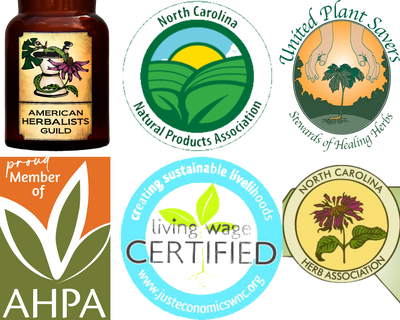Right Plant, Right Place- Harvesting Ethics & Growing Requirements Affect Availability
I grew up on a small, family farm in rural Appalachia, and we grew burley tobacco as a cash crop. We also maintained an apple orchard and grew a seasonal, annual vegetable garden. Old timey half-runners, striped double backs, October shelly beans, red striped greasy beans — these were just a few of the heirloom beans we grew, among other vegetables. In Ashe County, which is quite a bit further north than Buncombe, it was common practice to wait until after the danger of frost in late May to plant beans and many other garden vegetables. Peas and greens could go in earlier. So could potatoes. Greenhouse-grown tomatoes and pepper plants could go into the garden after the danger of frost had passed, but if you planted tomato or pepper seeds, the plants would not mature in time to create fruits and vegetables before the first frost of autumn. With beans, we put the seed right in the ground, and there was plenty of time for the beans to make. We knew what each plant needed, and each plant was different.
Each plant also originated from a different place in the world. Potatoes came from Peru (not Ireland). Tomatoes were native to western South America. Black-eyed peas, okra, and watermelon were native to Africa. Corn was native to Mesoamerica. Coffee is native to the highlands of Ethiopia. Beans were found in the tombs of the dead in ancient Egypt and mentioned in the Iliad. Beans have been a friend to people for a very long time. From all of the corners of the world, we gathered the plants we love to consume, and we have figured out how to grow many of them as annuals in our climate here in Southern Appalachia.
If you grew up in Southern Appalachia, like I did, you probably added many native Appalachian wild foods to your traditional diet, too — for example, black walnuts, ramps, branch lettuce, Sochan (a Cherokee name), blackberries, raspberries, and poke (which is toxic unless prepared appropriately). Appalachia also has beneficial native plants like ginseng, goldenseal, and cohosh. These native plants grow easily here, and they require no special preparations, unlike our vegetable gardens. For the most part, these plants can be wild foraged and do not need to be cultivated. Goldenseal and ginseng are exceptions because they have been driven to near extinction by unsustainable harvesting practices.
When I was young, I wandered awestruck through the forests of Southern Appalachia and learned about many native plants that were good to eat or beneficial for our bodies. I also wandered awestruck through the plant aisles at Lowes Hardware (when they first opened up in my small town, when I was in my teens). The bromeliads, tropical hibiscuses, and orchids stole my heart. Nothing else would do. I had to grow these tropical wonders, and I had to grow them in Southern Appalachia. Of course. Where else? This was my home. As a young adult, my house was filled with interesting tropical plants, many of which resided in gigantic pots — for example, a clivia, a dwarf lemon tree, a six-foot-tall brugmansia, and a night-blooming cereus. In the wintertime, my house turned into a tropical jungle, and all of the tropical plants suffered. Only one side of the house faced south, and window space was reserved for the most delicate specimens. Every winter, they barely survived, but by the end of summer, they were nursed back to health, only to face winter all over again.
Once, by accident, I started growing a papaya tree in my backyard. I didn’t know what it was. It arrived as a gift with other plants, and I stuck it in the ground. When it got big enough for me to identify it, it was too late. First frost was just around the corner, and it turns out, papaya does not like to be transplanted. I felt so bad for the little fellow, facing certain death. I tried to transplant it, but it didn’t work. In retrospect, that quick death might have been preferable to the suffering of those poor tropical plants stretching toward sunlight in my south-facing windows, with snow and ice on the ground outside.
I began traveling more earnestly. I didn’t have to go southward very far to see gigantic brugmansia growing easily as a perennial in someone’s lawn. The first time I saw the expansive bougainvilleas growing in New Orleans, I was awestruck. Then, I traveled to the Caribbean and saw the native orchids, bromeliads, and flamboyant trees, which took my breath away. And the breadfruits, starfruits, and mangos in Honduras. And the citrus orchards in Florida. I stopped growing tropical plants in my home entirely. It began to seem cruel. They were so happy and vibrant in growing zones where they flourished. Much like me, they didn’t want to see the snow. Rather than grow tropical plants in my home, I decided to become a migratory bird. Now, I fly south for the wintertime months, and I get my tropical plant fix in the tropics. Of course, it is possible to recreate the tropics in a greenhouse setting in Appalachia, and I have seen it done. However, I wouldn’t call the practice sustainable. The amount of energy and resources that go into maintaining a hothouse full of tropical plants for the entirety of an Appalachian winter seems exorbitant to me. It can be beautiful, though. To each their own. I will choose to travel. Right plant, right place.
As you probably know, Red Moon herbs takes pride in sourcing a tremendous portion of the plants we use in our products locally and sustainably. Many of our herbs are Appalachian-grown or wild foraged in Appalachia. If plants are wild foraged, they come from places that do not have any risk of chemical contamination — either by the recent flooding in Helene, by conventional agriculture, or for any other reason. Some of the plants for our products, however, do not grow well locally. We ask for your patience as we source these plants. We know our commitment to sustainable harvesting is important to you, and it is important to us, too.
Rhodiola rosea, or goldenroot, is one that many of our customers ask about frequently. This plant grows naturally in wild Arctic regions, and it is threatened in some places due to rapidly growing demand. It thrives in temperatures between 60 and 75 degrees. Ideal places to grow include Montana, Wyoming, and Vermont. For obvious reasons, this is a plant that is difficult for us to sustainably source at all, much less locally.
Another plant that many customers ask about is the tropical plant, Moringa oleifera. Moringa can be grown outdoors in frost-free zones (USDA zones 10 and 11), but in colder zones, Moringa must be grown as an annual or overwintered indoors. Moringa needs ample sunlight, well-drained soil, and temperatures between 77 and 95 degrees. We have heard about people successfully cultivating Moringa as an annual crop as close as Winston-Salem, and this is hopeful news. However, Moringa remains a plant on our difficult-to-sustainably-
We sustainably source our Ligusticum porteri — or commonly, osha — from western states. Osha is native to the Rocky Mountains, and it thrives in high-elevation, mountainous areas with specific soil and moisture conditions. The eastern United States is usually too humid for osha. The Appalachian region lacks the dry, high-elevation, rocky mountain habitat that Osha loves. Although we are usually able to sustainably source osha from the west, it nonetheless deserves a spot on this list, because it cannot be sustainably, locally sourced.
Milky Oats is one of Jeannie’s favorite extracts, and Red Moon takes pride in the milky oats we provide to you. We have noticed through years of experience and trial and error, that milky oats grown in the Piedmont is generally milkier than milky oats grown in the Appalachian mountains. Something about the heat down east really brings out the goodness of milky oats. Jeannie’s mom and dad live in the Piedmont, and they typically cultivate a patch of milky oats for Red Moon production.
The concept of “right plant, right place,” is crucial to any farmer attempting to cultivate any plant on a large scale. Agriculture is labor intensive, anyway. Farmers can choose to work with Mother Nature or against Mother Nature. I have discovered through my endeavors as a lavender farmer in Southern Appalachia that working with Mother Nature is a more positive experience than the alternative route, but my lavender endeavors are another blog post for another day. The concept of “right plant, right place,” is also very important to Red Moon Herbs as we strive to sustainably and locally source many of our herbal products for you. Hopefully, this post will help to explain to our customers why some extracts are sometimes unavailable. Our harvesting ethics combined with the growing requirements of certain plants necessitate that we cannot offer everything all the time. We ask for your understanding as we remain true to our harvesting ethics. We love y’all, and y’all means ALL.
Puma Love is a queer outsider artist at Puma Love Art and a lavender farmer at SpiralMountainFarm.com. Puma has been farming lavender on a large scale for eight years and has spearheaded the installation of multiple lavender fields, gardens, and orchards. In the winter months, Puma engages a nomadic lifestyle someplace warm, with his trusty sidekick of over a decade — Bella, a Jack Russell terrier mix. Puma creates watercolor paintings on a daily basis when he is not busy farming. He creates art to protest capitalism, to celebrate diversity, and to honor the Earth.







